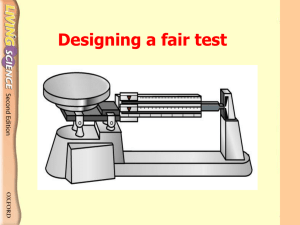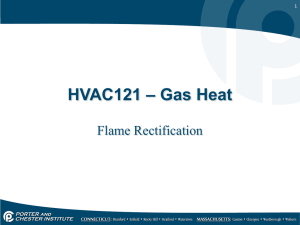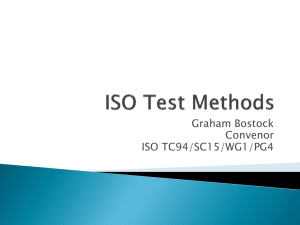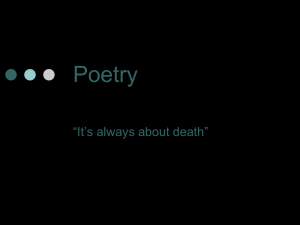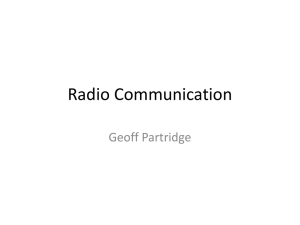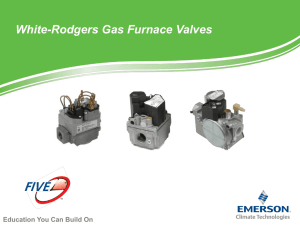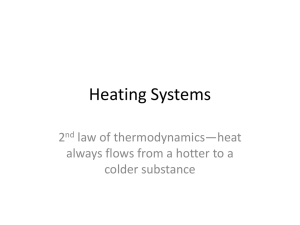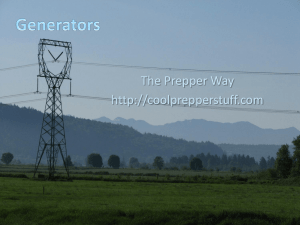Definition Flame spread over liquid pools
advertisement
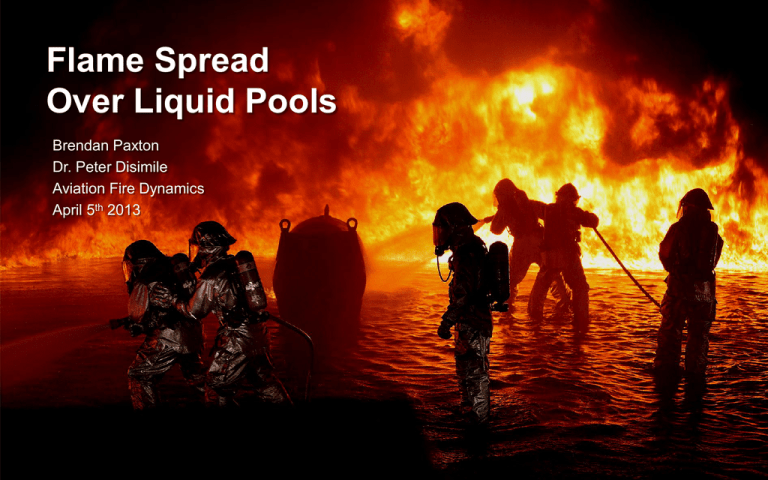
Flame Spread Over Liquid Pools Brendan Paxton Dr. Peter Disimile Aviation Fire Dynamics April 5th 2013 Agenda • Definition • Impact • Research – Fluid dynamics • • • Review Regimes of flame propagation Environmental disturbances – Suppression Definition • Flame spread over liquid pools: the result of a combustion process heating, vaporizing, and igniting proximal liquid fuel • Governing factors – Initial pool temperature and the flash point of the fuel – Environmental conditions Impact • Why research this phenomenon? – Fire presents danger to living beings and structures – Flame propagation over liquid fuels enlarges and intensifies a fire • • • Greater heat generation, leading to rapid vaporization of surrounding liquid fuel Greater volume of toxic gases Greater difficulty in extinguishment – Traveling flames may spread to fire-sensitive locations • Knowledge is power – Research is necessary for controlling fire propagation, isolating the pool’s source, and ultimately extinguishing the flames Impact • Aircraft crashes • Oil spills – Storage facilities – Tankers – marine, railway, road vessels – Marine drill sites • Solvent handling – Ethanol – Methanol – n-Propanol “…it looked like the sun exploded.” - Witness of an ethanol fire caused by the July 2012 train derailment in Columbus, Ohio Railcar Derailment Columbus, Ohio, July 2012 Effect: Catastrophic liquid ethanol fire http://www.youtube.com/embed/2tY2HzWCvhw?rel=0 China Airlines Flight 120 Okinawa, Japan, August 2007 Cause: Punctured fuel tank Buncefield Oil Depot Explosions Hertfordshire, England, December 2005 Cause: Liquid gasoline spill Buncefield Oil Depot Explosions Hertfordshire, England, December 2005 Cause: Liquid gasoline spill Buncefield Oil Depot Explosions Hertfordshire, England, December 2005 Cause: Liquid gasoline spill Buncefield Oil Depot Explosions Hertfordshire, England, December 2005 Cause: Liquid gasoline spill Research – Fluid Dynamics • Characteristic regimes of flame propagation 1. 2. 3. 4. 5. Pseudo-uniform, subflash Pulsating Transition Uniform, near-flash Uniform, superflash • Complex thermophysical interactions – Liquid convection, eddies, thermal currents – Pre-mixed gas-phase interactions Research – Fluid Dynamics • Characteristic regimes of flame propagation 1. 2. 3. 4. 5. Pseudo-uniform, subflash Pulsating Transition Uniform, near-flash Uniform, superflash • Complex thermophysical interactions – Liquid convection, eddies, thermal currents – Pre-mixed gas-phase interactions Review • What is the flash point? – The lowest temperature at which a substance can vaporize enough of its volume to form an ignitable mixture in air (this volume concentration is roughly the LFL) – Lower than the boiling point • What is vaporization? – Vaporization is the phase transition from liquid to gas • • Evaporization – vaporization near the surface (at temperatures below boiling point) Boiling – vaporization below the surface (at temperatures equal to and above boiling point) – Boiling occurs when the pressure of the atmosphere can no longer hold the molecules of substance in a liquid state – This occurs at the boiling point, the temperature at which the vapor pressure reaches the environmental pressure • What is vapor pressure? – The pressure exerted by a vapor on the environment – Dependent on the substance’s chemical properties and temperature Pv = vapor pressure T = fluid temperature A, B, C = chemical properties T → Pv → mv • Buoyancy effects – The density of a cold, unburned, gaseous fuel-air mixture is greater than the densities of its combustion products • • In an unconfined environment, a combustion process can be considered isobaric (constant pressure) Temperature changes lead to density changes – Buoyancy effects are seen when the lighter combustion products pass upward above heavier, unburned reactants – As the combustion products leave, cold air and vaporized fuel are entrained, or drawn toward the base of the flame Torch Torch Regimes of flame propagation 1. 2. 3. 4. 5. Pseudo-uniform, subflash Pulsating Transition Uniform, near-flash Uniform, superflash Pseudo-uniform, subflash regime • Slow propagation over cold liquid fuel – (Subflash temperature) – Laminar air entrainment with turbulent gas-phase mixing at flame front Pseudo-uniform spread • Spread appears uniform and steady • Long, slow pulsations – (a) and (b) represent diffusion burning • • Heating of fuel downstream of the flame front Slow and smooth flame propagation – (c) and (d) represent premixed burning • • • • Once the fuel becomes sufficiently heated, it vaporizes Vaporized air-fuel mixing creates a flammable layer The flammable gas-phase layer is ignited after reaching a sufficiently mixed state Rapid pre-mixed consumption • After burning quickly through the premixed vapors, the overall flame spread returns to reduced speeds, termed “crawl” Pseudo-uniform spread • Flames that extend through the premixed flammable layer may quench after arrival – Termed “precursor” flames – The liquid fuel at their new location might not be readily heated enough to sustain combustion – The flame front advances, but does not reach the location where the precursor flame quenches • Experiment, high-speed video – Capture: 300 fps, duration: 3 seconds – Playback: 30 fps, duration: 30 seconds Experiment performed at the University of Cincinnati Fire Test Center Assistants: Dr. Samir Tambe and Derick Endicott Video not attached due to size Regimes of flame propagation 1. 2. 3. 4. 5. Pseudo-uniform, subflash Pulsating Transition Uniform, near-flash Uniform, superflash Pulsating regime • Characterizations – Behavior similar to pseudo-uniform spread – Pulsations function with higher frequency and reduced wavelength (premixed propagation covers shorter distances during each pulsation) • High-speed video of precursor flame pulsations – Capture: 1000 fps, duration: 1.8 seconds – Playback: 30 fps, duration: 1 minute • Normal video of pseudo-uniform and pulsating spread – – Capture: 30 fps, duration: 1 minute Playback: 30 fps, duration: 1 minute Video not attached due to size Video not attached due to size Experiment notes and conclusions • Observations – – – – – Cold ambient temperature, 40°F, and low-volatility fuel, flash point = 100-151°F Spread acceleration (pulsations) even under concurrent and opposed air flow Average flame spread rate did not exceed 3.0 cm/s Boiling occurred after 2:30 beneath the flames, boiling point = 293-575°F Fuel began readily ejecting from the pan, even without wind flow • Personal thoughts – Experiment could only visualize subflash flame regimes – Served as realistic scenario of an ignited Jet-A pool • • Flame height for 16-inch diameter pool easily exceeded 20 inches Approximately 2.5 oz of Jet-A required 3 minutes to be fully consumed • Empirical support • Empirical support – – – – A = Pseudo-uniform, subflash B = Pulsating C = Uniform, near-flash D = Uniform, superflash – Methanol flash-point = 52°F – Ethanol flash-point = 56°F – n-Propanol flash-point = 72°F – Methanol pulsating spread rate = 6.0 cm/s – Ethanol pulsating spread rate = 5.5 cm/s – n-Propanol pulsating spread rate = 4.8 cm/s • Methanol pulsations reach over 15 cm/s, averaging around 6 cm/s Regimes of flame propagation 1. 2. 3. 4. 5. Pseudo-uniform, subflash Pulsating Transition Uniform, near-flash Uniform, superflash Transition regime • Characterizations – Very high pulsation frequencies, if pulsations even occur – Increased flame spread rate – Decreased liquid flow velocity relative to flame spread rate Regimes of flame propagation 1. 2. 3. 4. 5. Pseudo-uniform, subflash Pulsating Transition Uniform, near-flash Uniform, superflash Uniform, near-flash regime • Characterizations – Uniform spread, pulsations eliminated – Further reductions in liquid flow velocity – Primary heat transfer mechanisms • • • Gas-phase radiation Gas-phase convection Liquid-phase conduction – Minimized liquid-phase convection away from the flame front because the flame spread rate now exceeds the liquid flow velocity Regimes of flame propagation 1. 2. 3. 4. 5. Pseudo-uniform, subflash Pulsating Transition Uniform, near-flash Uniform, superflash Uniform, superflash regime • Characterizations – – – – Uniform, fast flame spread Liquid fuel consumption maximized Mostly occurs if the liquid fuel is heated above its flash point prior to ignition Rarely occurs after flames have spread through cooler regimes • • Example: gasoline combustion at room temperature High volumes of vapors ignited under superflash conditions will appear explosive – Often yields a “triple flame,” a premixed flame followed by a diffusion flame • • Air is entrained behind the premixed flame front This air undergoes diffusion combustion with the rapidly vaporizing fuel http://www.youtube.com/embed/yoDhfB5DyBQ?rel=0 • If T0 > Tst the flame propagation rate is 4-5 times faster than the stoichiometric laminar flame speed, Sl Uniform, superflash regime • 4-5 times faster than stoichiometric laminar flame speed? – Flame front is very curved, causing a significant pressure gradient across its surface – – – – Gas-phase motion ahead of flame front Gas-phase motion behind flame front, low-density products expanding This expansion displaces unburned gas layers ahead of the flame front Flame propagation rate increases Disturbances from the environment • Airflow, gusts of wind – Concurrent airflow, in the direction of flame propagation – Opposed airflow, against the direction of flame propagation – Considering uniform, superflash flame spread • • If the concurrent airflow exceeds the static flame spread rate, the flame spread rate will match the magnitude of the concurrent airflow Opposed airflow very gradually decreases the flame spread rate Strong opposed airflow Weak concurrent airflow Strong concurrent airflow Disturbances from the environment • Obstacles – Beds of solid material have been studied to simulate liquid pools that encounter porous surfaces or obstacles • • Solid material will reduce convective heat transfer Conductive heat transfer through the pool’s constituents will come into play – Balls or beads made out of sand, glass, and metal were tested – Flame propagation rates were reduced by factors between 30 and 50 – The slow flame speeds compared more closely with solid than with liquid fuels • • Obstacles only affect near-flash and preflash flame spread regimes Gas-phase flame spread will not “see” the solids • Airflow and obstacles – Opposed airflow greatly cuts flame propagation over a pool filled with solids – Considerable flow circulation and turbulent interactions around obstacles can even lead to instability and blow-off Disturbances from the environment • Contamination – Contaminants • • Water (by rain or condensation) Combustion products (soot, vapors) – Changes the thermocapillarity of the fuel, diminishing convective pre-heating Suppression • Class B fire extinguishants – Dry chemical (powders) • • • • • Pro – Separation of the fire tetrahedron Pro – Interference with the chain reaction, through reacting Pro – Halts production of fire-sustaining free-radicals Pro – Slows fire propagation Con – Difficulty in cooling the fuel, potential for flashback – Liquid-solid foams (frothy blanket) • • • Pro – Some dry chemical properties, smothering Pro – Cooling of the fuel Con – Does not interfere with the chain reaction, takes longer – Water, wet chemical (soapy foam) • • Pro – Cooling of the fuel Con – Mixes with the fuel, does not effectively displace oxygen – Clean agents (gases) • • • • Pro – Clean interaction, little residue Pro – Interrupts chemical reaction Pro – Displaces oxygen Con – Hazardous toxins (Halon) – Halon replacement Bromo–trifluoro–propene (BTP) generates hydrogen fluoride Water mist BTP 5% BTP 10% BTP Suppression • Dry chemical http://www.youtube.com/embed/LbExsN4jdcA • Liquid-solid foams http://www.youtube.com/embed/eHzUhm-3HX8 • Water, wet chemical http://www.youtube.com/embed/tavsFhniNVY Prevention – concluding thoughts • Gravel or sand could be useful in preventing liquid pool fire propagation at ground-based oil storage sites • Water mist could be useful in preventing liquid pool fires if it was sprayed/injected when a leak is detected, before ignition Questions? References [1] Guo, J., Lu, S., Li, M., and Wang, C., “Flame spread over aviation kerosene with an obstacle in liquid phase,” Journal of Thermal Science, 20, 6, 543-547, 2011. (http://link.springer.com.proxy.libraries.uc.edu/content/pdf/10.1007%2Fs11630-011-0508-z) [2] Hirano, T., and Suzuki, T., “Flame propagation across liquids—A review of gas phase phenomena,” Fire Safety Journal, 21, 3, 207-229, 1993. (http://www.sciencedirect.com/science/article/pii/037971129390028O) [3] Ishida, H., “Flame tip traveling in boundary layer flow with flammable mixture along fuel-soaked ground,” Journal of Fire Sciences, 30, 1, 17-27. (http://jfs.sagepub.com.proxy.libraries.uc.edu/content/29/2/99) [4] Remick, E. M., “Flame spread over liquid fuels,” Cornell University, 1981. (http://search.proquest.com/docview/303016167?accountid=2909) [5] Zhou, J., Chen, G., Li, P., Chen, B., Wang, C., and Lu, S., “Analysis of flame spread over aviation kerosene,” Chinese Science Bulletin, 55, 17, 1822-1827, 2009. (http://link.springer.com/article/10.1007/s11434-010-3014-x) [6] Xiaomin Ni, W.K. Chow, Performance evaluation of water mist with bromofluoropropene in suppressing gasoline pool fires, Applied Thermal Engineering, Volume 31, Issues 17–18, December 2011, Pages 3864-3870, ISSN 13594311, 10.1016/j.applthermaleng.2011.07.034. (http://www.sciencedirect.com/science/article/pii/S1359431111003930)

